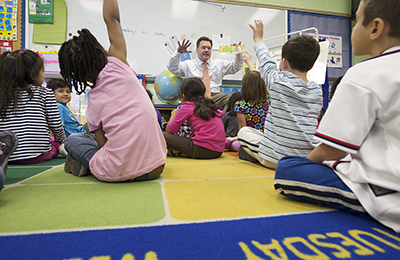Why Every Teacher Needs Preparation on Educating Diverse Students
 Illinois’ student population is rapidly growing more linguistically and culturally diverse. Close to one in every 4 public school children speak a language other than English in the home, according to Illinois census data. And the number of students who identify as English Language Learners (ELLs) statewide—now close to one out of every 10 students— has grown an astonishing 83 percent over the last 15 years. As these students transition into general education classrooms, nearly every teacher in the state will likely be working with ELLs at some point in their careers.
Illinois’ student population is rapidly growing more linguistically and culturally diverse. Close to one in every 4 public school children speak a language other than English in the home, according to Illinois census data. And the number of students who identify as English Language Learners (ELLs) statewide—now close to one out of every 10 students— has grown an astonishing 83 percent over the last 15 years. As these students transition into general education classrooms, nearly every teacher in the state will likely be working with ELLs at some point in their careers.
The increasing diversity of the Illinois student body stands in stark contrast to teacher demographics—largely white, female, and monolingual. The Illinois State Board of Education’s “Educator Supply and Demand in Illinois: 2011 Annual Report” indicates that currently 82 percent of the state’s teachers are white, while only six percent are African American and five percent are Latino. The imbalance between student-teacher diversity is illuminated in the national state teacher diversity index, where Illinois ranked 48.
The disparity of diverse teachers heightens the demand for pedagogical practices and clinical experiences responsive to how other languages and cultures differ from the dominant school language and culture. Translation: educators need training on how best to work with linguistic and culturally diverse populations. Encouragingly, teachers who are prepared to link home-school dissimilarities in interactions and communication can augment student participation within an array of academic endeavors.
Research clearly illustrates that teachers, in turn, want preparation in meeting the needs of the increasingly diverse student body in front of them. Good preparation allows educators to pay ample attention to the diversity of the student population in terms of country of origin, developmental characteristics, language development, parental education levels, the role of community, socioeconomic status, immigration status, duration in the U.S., familiarity with formal schooling, and ethnic and cultural background.
The question, therefore, is not if all Illinois teachers and educational leadership should be prepared to meet the spectrum of linguistic and cultural diversity in their classrooms, but how to address the issue.
To begin to address this question, I have organized a group of teachers and professors with expertise in linguistic and cultural competence to begin developing a comprehensive state-wide framework for preparing all Illinois teachers to educate diverse students. The work aims to advance collective dialogues on linguistic and culturally diverse students and teacher preparation (both pre- and in-service) in the region.
Preparing educators to meet the needs of linguistic and culturally diverse students is often relegated to solely preparing bilingual and English as a Second Language (ESL) specialists. Language, literacy, and content area teaching, however, are the shared responsibility of both ESL/bilingual and general education teachers. This is underscored by the heightened need for students to master academic language, as mandated by the Common Core Standards. To achieve this will require a new level of expertise for educators on how to support and integrate a student’s first language—even if the teacher does not speak that language.
Learn more about our education work here.
(PHOTO: U.S. Department of Education / Flickr / Creative Commons)
